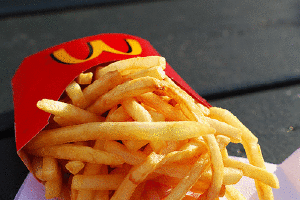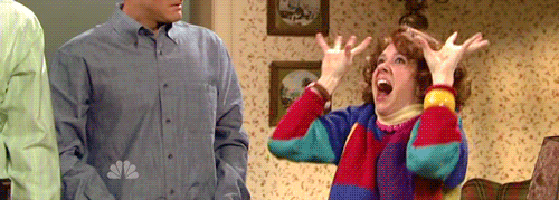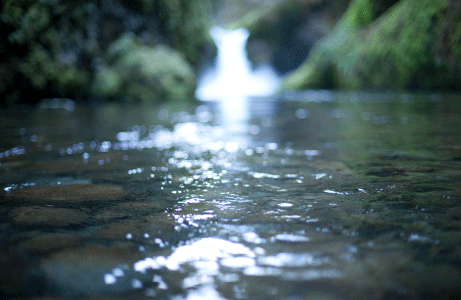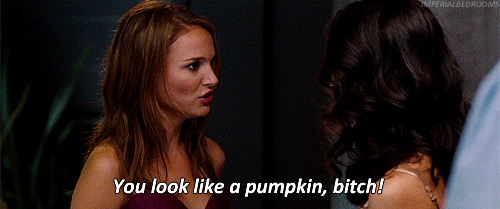
Other color psychology correspondingly states that red attracts attention, speeds up the body’s blood flow, and thus increases blood flow to the digestive system. This, of course, speeds up the metabolism and induces hunger.
More convincing proof is in chromotherapy, sometimes called color therapy. In this practice, red has always been used to stimulate the body and mind and to increase circulation.
Buttttt….
Of course, color is just one of the key factors of interior atmospheric properties. There are three pieces: environment factors (temperature, noise, scent, music, and lighting), design/structural factors (architecture, color, materials, pattern, texture, and layout of the store), and social factors (customers and employees). All of these elements make it difficult to bank on color psychology alone.
Relying only on color psychology is also unhelpful because, as research shows, aspects such as personal preference, experiences, upbringing, cultural differences, context, etc., often make the effect certain colors have on us unclear.
I know what you’re thinking: if the mere color red can make me hungry, will I ever be able to go anywhere or do ANYTHING without wanting to eat my face off all of the time? The answer is starting to look like a solid NO.
Here’s to hoping that we can resist the appetizing effects of those darn yellows and reds.

Gif courtesy of giphy.com
A color’s hue or gradation is directed by its wavelength. Short wavelengths are related to ‘cool’ colors, and long wavelengths are related to ‘warm’ colors, with red being the utmost ‘warm’ color.
During experiments scientists have controlled environmental color and view to dictate their effects on mood, pleasure, performance and enthusiasm. The results have suggested again that blue is a tranquilizing color and red and yellow are stimulating colors.

Other color psychology correspondingly states that red attracts attention, speeds up the body’s blood flow, and thus increases blood flow to the digestive system. This, of course, speeds up the metabolism and induces hunger.
More convincing proof is in chromotherapy, sometimes called color therapy. In this practice, red has always been used to stimulate the body and mind and to increase circulation.
Buttttt….
Of course, color is just one of the key factors of interior atmospheric properties. There are three pieces: environment factors (temperature, noise, scent, music, and lighting), design/structural factors (architecture, color, materials, pattern, texture, and layout of the store), and social factors (customers and employees). All of these elements make it difficult to bank on color psychology alone.
Relying only on color psychology is also unhelpful because, as research shows, aspects such as personal preference, experiences, upbringing, cultural differences, context, etc., often make the effect certain colors have on us unclear.
I know what you’re thinking: if the mere color red can make me hungry, will I ever be able to go anywhere or do ANYTHING without wanting to eat my face off all of the time? The answer is starting to look like a solid NO.
Here’s to hoping that we can resist the appetizing effects of those darn yellows and reds.
-

Gif courtesy of giphy.com

Gif courtesy of giphy.com
A color’s hue or gradation is directed by its wavelength. Short wavelengths are related to ‘cool’ colors, and long wavelengths are related to ‘warm’ colors, with red being the utmost ‘warm’ color.
During experiments scientists have controlled environmental color and view to dictate their effects on mood, pleasure, performance and enthusiasm. The results have suggested again that blue is a tranquilizing color and red and yellow are stimulating colors.

Other color psychology correspondingly states that red attracts attention, speeds up the body’s blood flow, and thus increases blood flow to the digestive system. This, of course, speeds up the metabolism and induces hunger.
More convincing proof is in chromotherapy, sometimes called color therapy. In this practice, red has always been used to stimulate the body and mind and to increase circulation.
Buttttt….
Of course, color is just one of the key factors of interior atmospheric properties. There are three pieces: environment factors (temperature, noise, scent, music, and lighting), design/structural factors (architecture, color, materials, pattern, texture, and layout of the store), and social factors (customers and employees). All of these elements make it difficult to bank on color psychology alone.
Relying only on color psychology is also unhelpful because, as research shows, aspects such as personal preference, experiences, upbringing, cultural differences, context, etc., often make the effect certain colors have on us unclear.
I know what you’re thinking: if the mere color red can make me hungry, will I ever be able to go anywhere or do ANYTHING without wanting to eat my face off all of the time? The answer is starting to look like a solid NO.
Here’s to hoping that we can resist the appetizing effects of those darn yellows and reds.

Gif courtesy of giphy.com
Is science saying that we see a few peaceful skies and forever lodged deep in our minds is the association of calmness and tranquility with the color blue? Maybe I’m exaggerating, but that’s pretty much how I reckon this whole thing.
So, what if something really dangerous (say, a drug) is colored blue? Judging by science of the mind, we’ll probably be persuaded to do it. #humans #issues
On the other hand, the color red (a warm color) tends to draw people in, exciting and energizing them.
-

Gif courtesy of giphy.com

Gif courtesy of giphy.com
A color’s hue or gradation is directed by its wavelength. Short wavelengths are related to ‘cool’ colors, and long wavelengths are related to ‘warm’ colors, with red being the utmost ‘warm’ color.
During experiments scientists have controlled environmental color and view to dictate their effects on mood, pleasure, performance and enthusiasm. The results have suggested again that blue is a tranquilizing color and red and yellow are stimulating colors.

Other color psychology correspondingly states that red attracts attention, speeds up the body’s blood flow, and thus increases blood flow to the digestive system. This, of course, speeds up the metabolism and induces hunger.
More convincing proof is in chromotherapy, sometimes called color therapy. In this practice, red has always been used to stimulate the body and mind and to increase circulation.
Buttttt….
Of course, color is just one of the key factors of interior atmospheric properties. There are three pieces: environment factors (temperature, noise, scent, music, and lighting), design/structural factors (architecture, color, materials, pattern, texture, and layout of the store), and social factors (customers and employees). All of these elements make it difficult to bank on color psychology alone.
Relying only on color psychology is also unhelpful because, as research shows, aspects such as personal preference, experiences, upbringing, cultural differences, context, etc., often make the effect certain colors have on us unclear.
I know what you’re thinking: if the mere color red can make me hungry, will I ever be able to go anywhere or do ANYTHING without wanting to eat my face off all of the time? The answer is starting to look like a solid NO.
Here’s to hoping that we can resist the appetizing effects of those darn yellows and reds.
-

Gif courtesy of giphy.com

Gif courtesy of giphy.com
Is science saying that we see a few peaceful skies and forever lodged deep in our minds is the association of calmness and tranquility with the color blue? Maybe I’m exaggerating, but that’s pretty much how I reckon this whole thing.
So, what if something really dangerous (say, a drug) is colored blue? Judging by science of the mind, we’ll probably be persuaded to do it. #humans #issues
On the other hand, the color red (a warm color) tends to draw people in, exciting and energizing them.
-

Gif courtesy of giphy.com

Gif courtesy of giphy.com
A color’s hue or gradation is directed by its wavelength. Short wavelengths are related to ‘cool’ colors, and long wavelengths are related to ‘warm’ colors, with red being the utmost ‘warm’ color.
During experiments scientists have controlled environmental color and view to dictate their effects on mood, pleasure, performance and enthusiasm. The results have suggested again that blue is a tranquilizing color and red and yellow are stimulating colors.

Other color psychology correspondingly states that red attracts attention, speeds up the body’s blood flow, and thus increases blood flow to the digestive system. This, of course, speeds up the metabolism and induces hunger.
More convincing proof is in chromotherapy, sometimes called color therapy. In this practice, red has always been used to stimulate the body and mind and to increase circulation.
Buttttt….
Of course, color is just one of the key factors of interior atmospheric properties. There are three pieces: environment factors (temperature, noise, scent, music, and lighting), design/structural factors (architecture, color, materials, pattern, texture, and layout of the store), and social factors (customers and employees). All of these elements make it difficult to bank on color psychology alone.
Relying only on color psychology is also unhelpful because, as research shows, aspects such as personal preference, experiences, upbringing, cultural differences, context, etc., often make the effect certain colors have on us unclear.
I know what you’re thinking: if the mere color red can make me hungry, will I ever be able to go anywhere or do ANYTHING without wanting to eat my face off all of the time? The answer is starting to look like a solid NO.
Here’s to hoping that we can resist the appetizing effects of those darn yellows and reds.
It’s often said that the colors red and yellow make us hungry. I don’t know about you, but I’ve always believed that fact to be the most random and most far-fetched shit I’ve ever heard.
It’s not, I guess, if you believe in COLOR PSYCHOLOGY.
The scientific truth is that color has a crazy influence on our perception, likes/dislikes, and most definitely our mood.

Gif courtesy of giphy.com
I.E. the “red and yellow makes you hungry” BS is persuasive if you think about mental processes and the science of the mind, and especially if you consider how complex and f**ked up the human brain is.
For example, psychologists say that the color blue has a calming effect on people—why? Because it reminds us of tranquil things like the ocean or the sky.
-

Gif courtesy of giphy.com

Gif courtesy of giphy.com
Is science saying that we see a few peaceful skies and forever lodged deep in our minds is the association of calmness and tranquility with the color blue? Maybe I’m exaggerating, but that’s pretty much how I reckon this whole thing.
So, what if something really dangerous (say, a drug) is colored blue? Judging by science of the mind, we’ll probably be persuaded to do it. #humans #issues
On the other hand, the color red (a warm color) tends to draw people in, exciting and energizing them.
-

Gif courtesy of giphy.com

Gif courtesy of giphy.com
A color’s hue or gradation is directed by its wavelength. Short wavelengths are related to ‘cool’ colors, and long wavelengths are related to ‘warm’ colors, with red being the utmost ‘warm’ color.
During experiments scientists have controlled environmental color and view to dictate their effects on mood, pleasure, performance and enthusiasm. The results have suggested again that blue is a tranquilizing color and red and yellow are stimulating colors.

Other color psychology correspondingly states that red attracts attention, speeds up the body’s blood flow, and thus increases blood flow to the digestive system. This, of course, speeds up the metabolism and induces hunger.
More convincing proof is in chromotherapy, sometimes called color therapy. In this practice, red has always been used to stimulate the body and mind and to increase circulation.
Buttttt….
Of course, color is just one of the key factors of interior atmospheric properties. There are three pieces: environment factors (temperature, noise, scent, music, and lighting), design/structural factors (architecture, color, materials, pattern, texture, and layout of the store), and social factors (customers and employees). All of these elements make it difficult to bank on color psychology alone.
Relying only on color psychology is also unhelpful because, as research shows, aspects such as personal preference, experiences, upbringing, cultural differences, context, etc., often make the effect certain colors have on us unclear.
I know what you’re thinking: if the mere color red can make me hungry, will I ever be able to go anywhere or do ANYTHING without wanting to eat my face off all of the time? The answer is starting to look like a solid NO.
Here’s to hoping that we can resist the appetizing effects of those darn yellows and reds.


